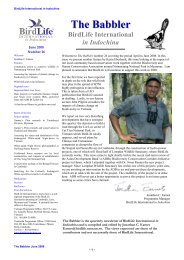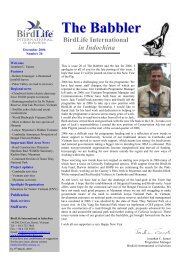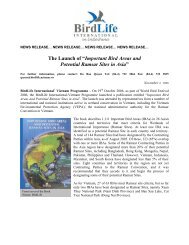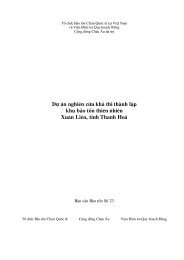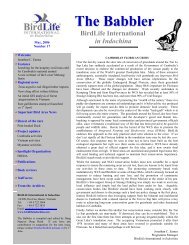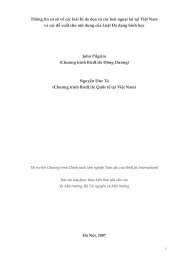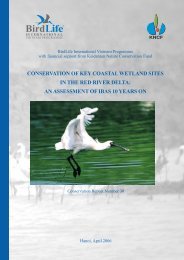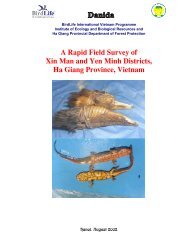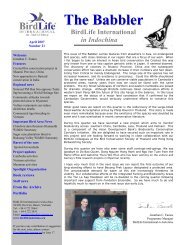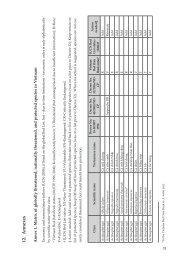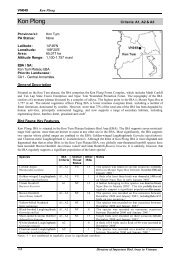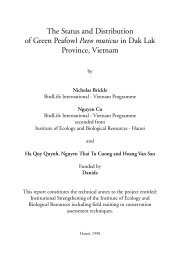A Feasibility Study for the Establishment of Xuan Lien Nature ...
A Feasibility Study for the Establishment of Xuan Lien Nature ...
A Feasibility Study for the Establishment of Xuan Lien Nature ...
Create successful ePaper yourself
Turn your PDF publications into a flip-book with our unique Google optimized e-Paper software.
Section 3 - Evaluation<br />
limitations <strong>of</strong> <strong>the</strong> field survey.<br />
The conservation value <strong>of</strong> <strong>the</strong> proposed nature reserve with respect to avifauna can be seen clearly by comparing<br />
<strong>the</strong> number <strong>of</strong> globally threatened and Near-threatened bird species in protected areas in Thanh Hoa and Nghe<br />
An provinces (Table 19). By this measure, <strong>Xuan</strong> <strong>Lien</strong> proposed nature reserve is second only to Cuc Phuong<br />
National Park which does not lie wholly within Thanh Hoa province and, as previously mentioned, has been<br />
studied in greater detail.<br />
One reason why a larger number <strong>of</strong> globally threatened and Near-threatened species are known from <strong>Xuan</strong> <strong>Lien</strong><br />
may be that it is <strong>the</strong> only site in Thanh Hoa province which contains evergreen <strong>for</strong>est above 800 m; Short-tailed<br />
Parrotbill, Green Cochoa Cochoa viridis and Grey Laughingthrush are all restricted to <strong>for</strong>est above c.600 m<br />
(King et al. 1975). Additionally, <strong>the</strong> number <strong>of</strong> threatened and Near-threatened species at Pu Hoat, Pu Luong<br />
and Pu Hu may be under-recorded due to limitations <strong>of</strong> previous surveys <strong>of</strong> <strong>the</strong>se areas in terms <strong>of</strong> time and<br />
expertise.<br />
Endemism<br />
As mentioned previously, four endemic plant species (Cinnamomum balansae, Colona poilanei, Croton boniana<br />
and Macaranga balansae) were recorded in <strong>the</strong> study area. Animal species endemic to Vietnam or to Vietnam and<br />
Laos include two mammal species (Roosevelt’s Muntjac and White-cheeked Gibbon), two bird species (Shorttailed<br />
Scimitar Babbler and Red-vented Barbet), one herpetile species (Rana microlineata) and 10 butterfly<br />
species.<br />
26<br />
3.3 Evaluation <strong>of</strong> Economic Factors<br />
Watershed Protection<br />
The <strong>for</strong>est cover <strong>of</strong> <strong>the</strong> study area plays an important role in protection <strong>of</strong> watershed areas, protection <strong>of</strong> water<br />
resources, prevention <strong>of</strong> soil erosion and, especially, provision <strong>of</strong> wildlife habitat. The <strong>for</strong>est cover <strong>of</strong> <strong>the</strong> proposed<br />
nature reserve protects <strong>the</strong> catchment <strong>of</strong> <strong>the</strong> Chu River, which will supply <strong>the</strong> proposed Cua Dat irrigation<br />
and hydro-electricity dam. Cua Dat dam will regulate <strong>the</strong> flow <strong>of</strong> water to hundreds <strong>of</strong> thousands <strong>of</strong> hectares <strong>of</strong><br />
rice fields <strong>of</strong> Thanh Hoa province. The water level <strong>of</strong> <strong>the</strong> proposed artificial lake will rise to 100 m above sea<br />
level, and <strong>the</strong> inundated area will include areas <strong>of</strong> agricultural land in <strong>Xuan</strong> My and <strong>Xuan</strong> <strong>Lien</strong> communes; only<br />
small areas <strong>of</strong> <strong>for</strong>est within <strong>the</strong> proposed nature reserve will be inundated.<br />
Soil Conservation<br />
Most <strong>of</strong> <strong>the</strong> <strong>for</strong>est ecosystems in <strong>the</strong> region occur on steep hills and mountains where soil is readily eroded if <strong>the</strong><br />
<strong>for</strong>est cover is disturbed. Moreover, irrigation and hydro-electricity projects depend upon preservation <strong>of</strong> <strong>for</strong>est<br />
cover in order to avoid soil erosion and resulting siltation. A long-term <strong>for</strong>est and biodiversity conservation<br />
strategy should be prepared <strong>for</strong> <strong>the</strong> nature reserve to ensure adequate protection <strong>of</strong> soil and <strong>for</strong>est cover.<br />
Forestry Resources<br />
<strong>Xuan</strong> <strong>Lien</strong> proposed nature reserve contains <strong>the</strong> valuable timber species Fokienia hodginsii. Areas <strong>of</strong> mixed coniferous<br />
and broadleaf evergreen <strong>for</strong>est containing this species only cover a small fraction <strong>of</strong> <strong>the</strong> area <strong>of</strong> <strong>the</strong> proposed<br />
nature reserve, <strong>of</strong>ten in remote, inaccessible locations, making <strong>the</strong> commercial exploitation <strong>of</strong> this species unpr<strong>of</strong>itable.<br />
However, <strong>the</strong> high value <strong>of</strong> this species and low income levels <strong>of</strong> local people mean that selective<br />
logging <strong>of</strong> even <strong>the</strong> most remote areas is economically viable <strong>for</strong> local people. There<strong>for</strong>e, specific conservation<br />
measures should be implemented to prevent over-exploitation <strong>of</strong> this globally threatened species (IUCN 1997).<br />
Medicinal and Ornamental Plants<br />
One hundred and sixteen plant species with known medicinal uses were recorded during <strong>the</strong> field survey. These<br />
species already have a high value to local people, ei<strong>the</strong>r through personal use or trade, however, <strong>the</strong>re is potential<br />
<strong>for</strong> developing commercial production <strong>of</strong> traditional plant-based medicines, ei<strong>the</strong>r through sustainable exploitation<br />
<strong>of</strong> medicinal plants in <strong>the</strong> <strong>for</strong>est or through cultivation <strong>of</strong> selected species.




